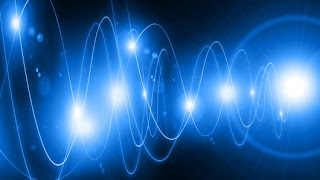 |
| Einstein's General Relativity |
Einstein realised that gravity could have some profound effects on light. Probably the best known is the bending of light near a star.
The the idea for an experiment to confirm this is one of my favourites. The most obvious large object, capable of bending light according to Einstein's theory of general relativity, is our sun. The problem of course is that it is also remarkably bright and any stars near it are lost to its glare. The solution depends on one of those truly remarkable quirks of nature, the lunar eclipse. During a full eclipse it is actually possible to see stars near the edge of the sun.
So we measure angles between stars really close to edge of the sun and some further out. We then repeat the same measurement some time later after the sun as moved round and the stars are no longer in the direct line of site. The idea being that if light is being bent then the two angles, before and after, will be different.
 |
| Bending of light (Exaggerated) |
The result was that the angles actually change and by an amount predicted by Einstein. Which is simply amazing. The explanation for this phenomena is that space-time is actually warped by gravitation fields and so the path of a light ray will also be warped. What a mind blowing idea that is! It is particularly odd if you find yourself in a box in space.
This wasn't the only effect gravity has on light. Another absolute beauty is gravitational red shift. Imagine standing in a long lift shaft and shining a torch upwards.
According to Einstein the difference in the gravitational pull on the light is different at the bottom of the shaft than at the top. This change in gravity causes time dilation.
What this means is that two clocks, one at the bottom of the lift shaft and one at the top run at slightly different rates, even if they are identical clocks. What this means for the light shining up the lift shaft is that the frequency of the light is shifted slightly to the red end of the spectrum.
Shining the light from the top of the shaft to the bottom of the shaft has the opposite effect and in this case the light is shifted to the blue end of the spectrum, known as blue shift.
Great, so let's give it a go. There is a slight problem though, the amount of shift is very very small and is difficult to measure. The solution was an experiment by Robert Pound and Glen Rebka using an idea known as the Mossbauer effect (I'll cover this in a post of its own at a later date).
What Mossbauer had realised was that atomic nuclei can emit gamma rays that can be absorbed by a second atom of the same type. What Pound and Rebka realised was that if this gamma ray went down a lift shaft then its frequency would change just enough that it would no longer be absorbed.
They took it one step further and realised that if they moved the source of the gamma rays at a particular speed they could cancel out the shift due to gravity with a Doppler shift (I'll cover this one later as well!) and the gamma ray would once again be absorbed by the atom at the bottom of the lift shaft!
They performed these experiments using a radioactive type of iron, Fe-57, and sure enough it came out as predicted by Einstein. This was a fantastic result, and shows just how brilliant Einstein was.
Many theories try to explain phenomena that we have already witnessed by experiment. Einstein's theory not only explained what we had already seen, but went further to make predictions about things we had not seem, yet were found to be true.
In a way this is what makes things both interesting and difficult in physics. General relativity has been tested by experiment and found to be true. So has quantum mechanics. Quantum Electro Dynamics (QED) has been tested to a higher degree of accuracy than any other theory. The problem is that it has not been possible to reconcile these two different theories. One works on the macro, the other, the micro.
So, we were discussing the nature of light and somehow we have staggered into gravity! Really, this is the point of this post. Irrespective of the physical phenomena, bending of light, red or blue shift gravity, gravity has an observable effect on light. Which means that it must be having the same effect on individual photons of light.
Now it can be argued that gravity is distorting space time and it is this distortion of space time that we are observing when we look at how light is effected by gravity.
I am not completely convinced by this and the reason is that I don't think it is possible to separate out space-time and light. I think that the two are intrinsically linked. It will be this link that I will be covering in the next post on the nature of light. It is this link that I think shows that light must have a gravitational component.
Then again, I could be completely wrong!


 is the wavelength
is the wavelength is the Planck's constant
is the Planck's constant is the momentum
is the momentum is the
is the  is the
is the  is the
is the 







